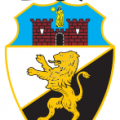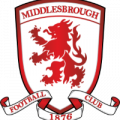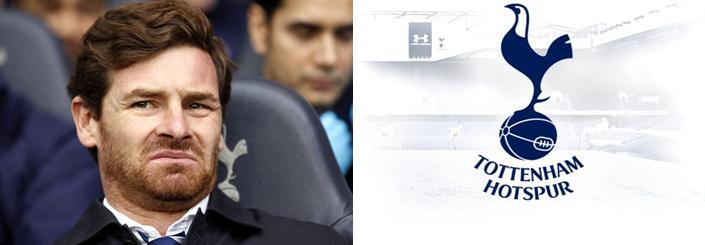Superficially, one could say that Andre Villas Boas led Tottenham to a worse season than the one they had just before, with Harry Redknapp. They missed out on Champions League football, by finishing a place below the top four and did not make it as far in the FA Cup. There are some mitgating factors for the talented Portuguese manager like the fact he lost Luka Modric and Rafael van der Vaart, two major players in the Spurs squad. Also, he did not have an in from striker like Adebayor, when he was on loan at Tottenham from Manchester City.
Gylfi Sigurdsson and Clint Dempsey did not play to the best of their ability throughout the season whilst Younes Kaboul and Sandro had lengthy lay offs from the first XI. All of this made a situation for Villas-Boas where he had to change his philosophy to fit it into what he had to make due with. A 4-2-3-1 one that did not really encompass everything that he wants to was formulated and worked but only did so when it relied heavily on a goalscoring Gareth Bale. Now, with all the areas that needed to be fixed potentially being done so, it could lead to AVB finally stamping his authority, thus playing style, on this Tottenham Hotspur squad.
A Villas Boas 4-3-3
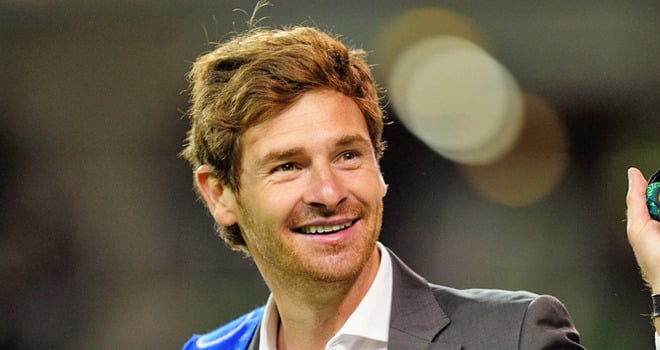
In the boy of Mourinho's hugely maligned stint as Chelsea manager in the 11/12 season, he forced a progessive, Barcelona lite, if you will, on a Chelsea team that simply did not have the capability to fulfil what he wanted. Starting from the back, when the goalkeeper was kicking out from a goal kick, the two CBs would split and Petr Cech would be encouraged to play it out to either one or the defensive midfielder. The defence were told to play a high line for two reasons: to catch the opposition's forwards offside and get the ball turned over and the other being to make the pitch as small as possible so as to concentrate the play in midfield, where the philosophy wants the football to be played. He could not do so at Chelsea but in his one year at Porto, he employed a rotating midfield. This is where one midfielder could take the place of another and perform the role that he was doing. The whole team was expected to keep the ball well and for the majority of the game. In his front three, he had one that would come in from the right and strike on goal - Hulk and Daniel Sturridge -, a striker who was only concerned with goals - Falcao and was supposed to be Fernando Torres - and then on the left he would have an auxillary attacker.
A Villas Boas 4-2-3-1
At Tottenham, he started off trying to use this but it led to three poor results against Newcastle, West Brom and Norwich. Then, in the next game when his took his side to the Madejski Stadium to face a newly promoted Reading side, he changed to a 4-2-3-1 where he played Sigurdsson behind Jermain Defoe, Bale and Aaron Lennon flanking them both. Moussa Demble and Sandro sat in front of the defence. In this game, the 4-2-3-1 became a 4-3-3 when they defended, to which Reading had very little response to. From January onwards, Bale was deployed in a position behind the striker as he was said to have sat down with AVB and told him that he was not enjoying his football out on the wing. Also, Bale would be closer to the goal and potentially contribute more to the Tottenham goal scored tally. The talismanic Welshman played some of the best football of his career and almost single handedly took them into the Champions League qualification places.
Centre Backs
In the system, the centre backs are incredibly important in distributing the ball to the midfield so have to be adept at playing the ball out from the back and this could be under intense pressure. When he was at Chelsea, John Terry and David Luiz were very good at passing the ball to their desired target. So much so that Terry had one of the best passing accuracy rates in Europe in the 2011/12 season due to the influence of Villas Boas. Jan Vertonghen came through at Ajax were they are taught from a young age to be comfortable on the ball and passing it to a teammate. At White Hart Lane, he has managed to show this side of his game whilst remaining defensively solid. His passing accuarcy in the 34 games, in the Premier League, is 87.1% with an average on 48 passes per game.
He plays 3.6 accurate long balls per game and contributes 0.7 key passes per game, on average. Michael Dawson's defensive statistics, in terms tackles, interceptions and tackles, are not as high as his defensive counterpart. He performed more clearances and long balls, suggesting that he is more direct, maybe too much so for Villas Boas.
He was obviously the deeper of the two as he was dribbled around less and performed more last ditch tackles and blocks going by the amount of blocked shots he had over the season. Dawson only had competition for Steven Caulker and William Gallas, who, with all due respect, are not of the calibre that woudl challenge AVB into making a decision. Now that Kaboul is coming back, it becomes more interesting.
Younes Kaboul had a fabulous season in Harry Redknapp's last season at the Bill Nicholson Way helm. In my opinion, out of all at the club, he was the standout performer above the likes of Luka Modric, Scott Parker and Bale. He cleaned up the back line very well, showed great prowess on the ball and had the pace to track runners who had managed to breach the backline without being called offside. Unfortunately, he suffered a long layoff that was compounded with other injuries when he was trying to make his come back.
He played one game at the beginning of the season against Newcastle and from then, did not feature in any more of Tottenham's competitive first team games. Kaboul is more likely to be a better fit to the Villas Boas model than Dawson is, as the latter is more of a quintessential English defender and that is something that does have everything that the Portuguese manager would like in a defender. So, it is likely that next season that Dawson is fazed out in favour of slowly bringing Kaboul back in the frame.
Interchangeability in Midfield?
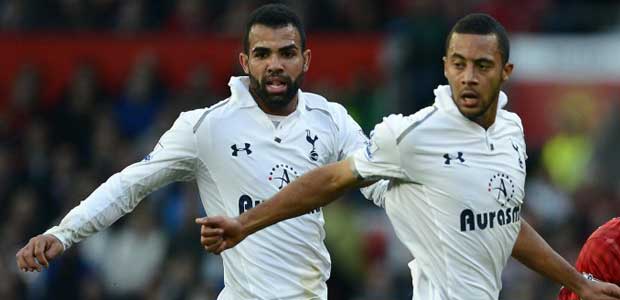
One thing that was synonymous with Andre Villas Boas was that he always wanted to play the 4-3-3 because it was a formation that was built on holding the ball and being in possession of it. It was something that was considered a major downfall in his time at Chelsea because Juan Mata would have been better in a more central role or even Sturridge could have been played behind the striker. Alas, he was stringent in his views and refused to leave. Showing that he had learned from his time under the 'frightful' helm of Roman Abramovich, he adapted to his surroundings when it was shown that he could not simply continue with the same formation and he would need to reign in his style to do that. Thus, this gave birth to the idea Sandro and Dembele playing the double pivot together. The Brazilian, ironically, the more defensive minded of the pair and does his best work breaking up the play and distributing the ball to his better technically endowed team mates. Dembele is more the passing kind of midfielder, as shown by his 90% passing accuracy, on average, in the Premier League. He helps with the defensive side of the game and is very good at dribbling past players.
However, when Bale plays in front of them, he does not have the defensive tactical intelligence to close down the deepest midfield and this would allow other teams to build from the back. Against the top clubs, this would often be the best passer of the football and that would lead to disaster. The heavy interest in Paulinho makes a lot of sense in changing to suit the progressive 4-3-3 that is associated with Andre. The complete midfielder from Corinthians speciality is that he can fulfil most roles in the midfield well. He can help shield the defence and break up the play. He has the passing ability to pick out a player from deep or could break up field with the ball as he possess great pace and power in his running. Also, he does not look out of place when he is in the final third as he could stick the ball away. Having a tuttofare, which they are specially known as, would offer more protection against and add to the possessive prowess of the team.
The Front Line
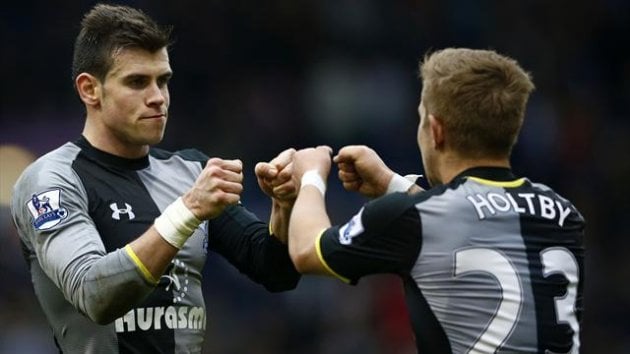
Given that Spurs are likely to invest in a striker, Bale might be finding himself on the wing due to that and the arrival of Paulinho. However, he had a sit down with AVB earlier in the season where it was said that he was not enjoying his football as much as he wanted. It was agreed that he would be given a costless role in the team behind the striker and the rest is history. He went on to be the third highest goalscorer in the league, which, contentiously, lead to him winning the PFA and FWA Player of the Year award for the 2012/13 season. His thunderous shot, lightning quick pace and improved finishing meant that he was able to push Tottenham to a strong finish and was a strong catalyst that saw them go on 12 match unbeaten run. There is still a place in the team for Bale where he would excel and that would be from the right side. Under AVB, Hulk and Falcao had their best goalscoring season, so far. Also, Hulk got 21 assists to go with his 36 goals that he scored in all competitions. He would cut in from the right and shoot from far or stretch the defence with his speed, to slot home. These are attributes shared with Bale that would be put to good use if he were to be played from the right side.
So if the Welshman is to play from the right and then Tottenham were to sign a striker in the ilk of Leandro Damiao or David Villa, the only question is who will be playing on the right hand side. Now there are two options: Lewis Holtby - a creative left footed attacking midfielder - or Aaron Lennon - a direct 'chalk booted' right footed winger. In his stint at Porto, he went with Varela, who is very much like Lennon but when at Stamford Bridge, he played with Mata, who is more similar to Mata. If I were to make a decision between the two, then it would be Holtby given the midfield composition. Joao Moutinho and Fernando Belluschi were components of that midfield and they have a playmaking edge to them so a winger with creativity would not be as needed as much. However, in his 8 months at Chelsea, he did not have a creative specialist in midfield so felt he had to play Mata otherwise there would be a distinct lack of creativity in the team. The midfield mentioned above does not have the passing specialist so it is likely Holtby would be chosen.
Change for change sake or Is it a necessity?
This is how I envisage the team that Andre Villas Boas would put out if he were to change to a style that he is comfortable with. However, this leads into a difficult question. Is it better to coach what you know extensively but is alien to most players or coach what you know just enough for the sake of the players? Effectively, this is long term against short term, as there will come a time where his tactical knowledge of the formation will have to be used in order to enhance the team's strength. This was evident when Alan Pardew was playing a 4-3-3 to fit in Demba Ba and Papiss Cisse when he did not know how to do it well enough. He could not work on the movement off the ball to tell the players where to drag what opponent in order to create space needed to exploit a weakness that should ultimately lead to a goal. So in order for Tottenham to progress from where they were from last season they can not do it on signings alone, like Harry Redknapp did, and would have to fully back Andre Villas Boas in his pursuit to build his progressive 4-3-3.































